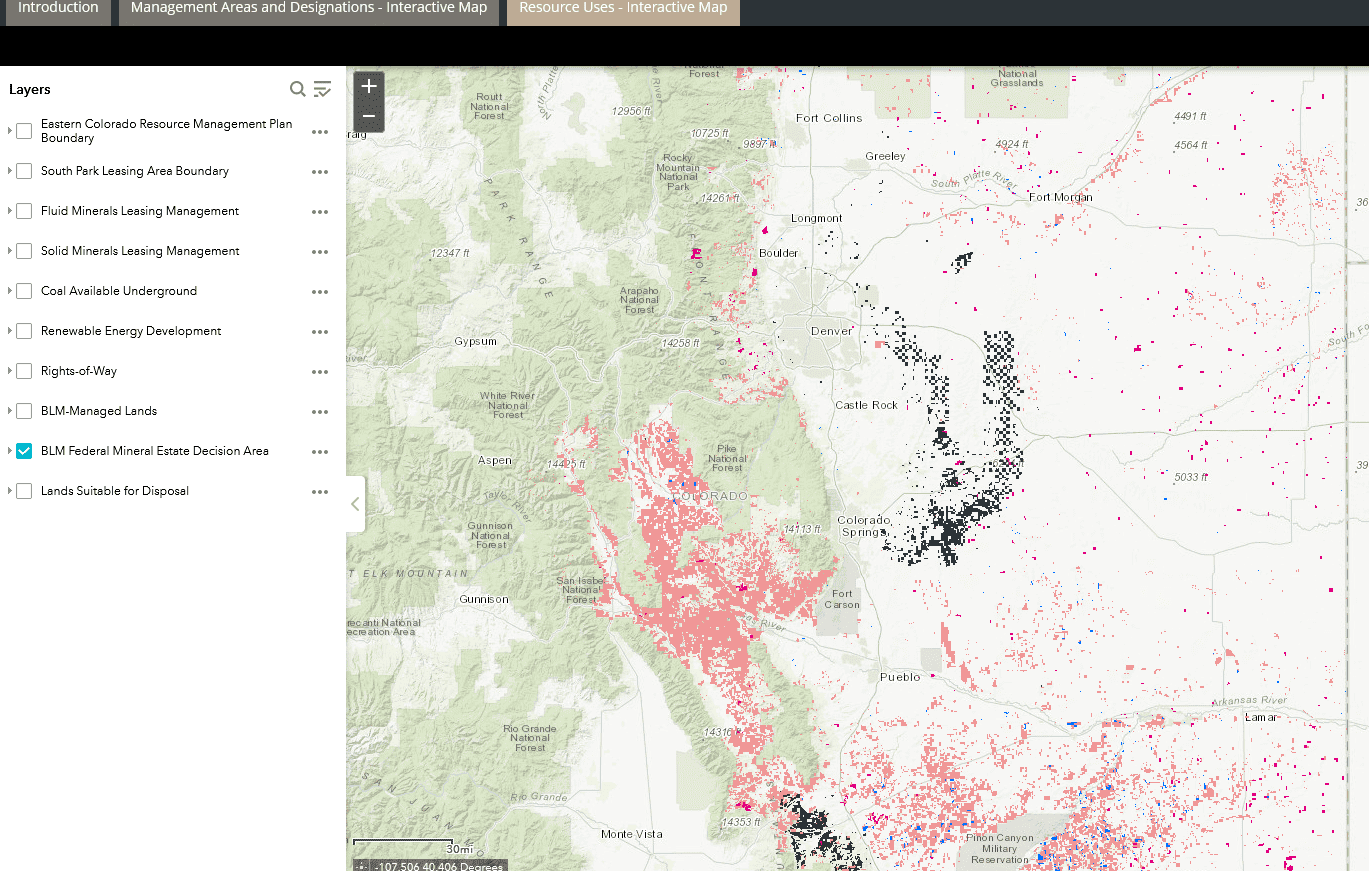First thing.. this RMP covers more subsurface mineral estate than surface
The Eastern Colorado RMP planning area consists of approximately 35 million acres of land under various jurisdictions in eastern Colorado, including 7,177,100 acres of federal mineral estate, which may lie beneath other surface ownership. The BLM actions considered in the Approved Eastern Colorado RMP would only apply to those areas for which the BLM has the authority to make management decisions (the decision area), which comprise 658,200 acres of BLM-administered surface land and 3,311,900 acres of BLM-administered mineral estate.
If you’re interested, I posted some maps below.
According to TRCP, the fact that there was a South Park Coalition made the difference.
Before the formal planning process began, Park County, Colorado Wildlife Federation, TRCP, several other conservation organizations, and water providers came together as the South Park Coalition and began identifying areas suitable for development and areas key to conserve.
“I think the work we did well before the formal process made a big difference to enable the really good outcome for the unique resources of the South Park area,” said Suzanne O’Neill, executive director of the Colorado Wildlife Federation. “We applaud BLM’s recognition throughout the process of this iconic basin’s distinctive and largely unfragmented wildlife habitats, prized trout streams, water quality, and spectacular vistas. In addition, the plan’s treatment of the areas managed by BLM in eastern Colorado outside of South Park has been much improved.”
This is a good story from the Colorado Sun. Apparently CBD is not a fan.
“Unfortunately, the BLM maintains the status quo, which is basically the oil and gas industry can have whatever it wants, whenever it wants, and however it wants,” said Nichols, whose group estimates the plan allows for a doubling of oil production on public lands over 20 years. “And that is not a solution to both the climate crisis or the clean air crisis that is affecting the Denver Metro area and the Northern Front Range.”
And many wildlife groups and the energy folks are satisfied.
“BLM chose a balanced alternative, not the most extreme conservation-only alternative,” said Kathleen Sgamma, president of the Western Energy Alliance. Of course some environmental advocates are not happy, she said, because they are “never happy unless a decision is made that shuts off all oil and natural gas, but that would be unlawful. BLM has a duty to balance energy development with environmental protection.”
I thought what the Royal Gorge District Manager had to say was interesting:
The BLM’s Royal Gorge district office, which guided the resource plan, said the draft process included a long schedule of community meetings for input. The BLM’s call for public involvement included a first-time effort to divide the broad swath of Colorado into four geographic regions with a unique sense of geography and culture. South Park community advocates had a big impact on the plans, Royal Gorge district manager Keith Berger said.
The early 2019 draft of the now-final plan had only about 1,300 acres set aside for land with wilderness characteristics, Berger said, and public calls for more eventually pushed the BLM to set aside more than 114,000 acres in that protected category.
Oil and gas development was taken off the table for 93% of the Eastern Colorado land, he added. (Nearly all the mineral rights BLM deals with in Eastern Colorado are oil and gas, rather than coal rights the agency controls in other districts.) BLM decided to allow new oil and gas development in northeast Colorado, for example, in part because those areas already have oil and gas as a common land use, he said. Much of the BLM-controlled mineral right is interspersed with private lands where oil and gas drilling is already dominant.
If BLM stops new leasing, the technology of fracking allows a private well nearby to reach underground and take federal resources without compensating the U.S. taxpayer through royalties, Berger noted.
“It sets up a scenario where the federal mineral estate would still be drained by that adjacent development going on on private lands,” he said.
If that’s true, then can what Ramey says here be equally true?
“While we celebrate the new lands protections, it’s confounding that the final plan will increase climate-damaging emissions,” said Jim Ramey, Colorado State Director for The Wilderness Society. “
Do Ramey and CBD disagree that the gas will be extracted either way? I would have asked, since both of their statements would not be true if that is the case (increase emissions). Aside from the whole “reducing emissions by keeping fossils in the ground in the US is the best way to reduce global emissions” argument which I don’t agree with.
Anyway, check it out. It does make you wonder whether there might be a partisan subtext to choosing the preferred alternative in Wyoming.
It’s a little confusing, because to Coloradans, “eastern Colorado” is not in the mountains, whereas most of the BLM surface in this RMP is. Here’s the surface estate:
If I used the eplanning site correctly, here’s the subsurface estate. I haven’t figured out the red vs. black. Maybe someone can help?


I didn’t necessarily see a disagreement between Berger and Ramey because I read Berger’s comment as being limited “northeast Colorado, for example, in part because those areas already have oil and gas as a common land use.” My question about that was why not utilize lateral drilling from adjacent existing developed sites on private land instead of allowing additional disturbance on public lands? (The royalties? Really?)
A. I’m thinking that there are probably some statutes and regulations against giving away the federal mineral estate to those who happen to own nearby mineral rights.
Also interesting side note, I’ve been on field trips with various ENGO groups who didn’t want drilling underneath federal lands either, even if there was no surface occupancy. Possibly there was a “leave it in the ground” feeling. I don’t really know..